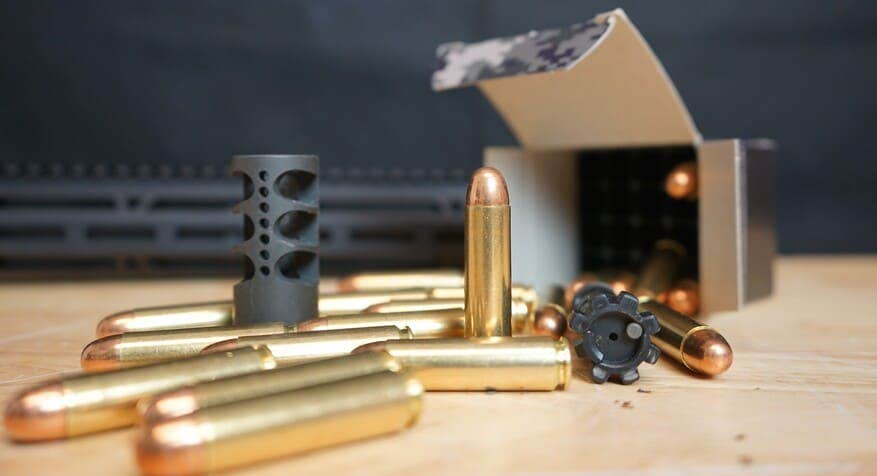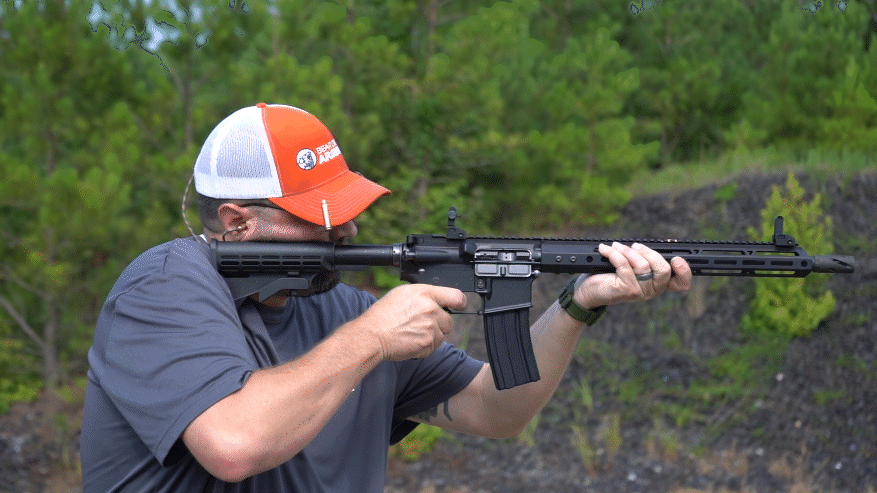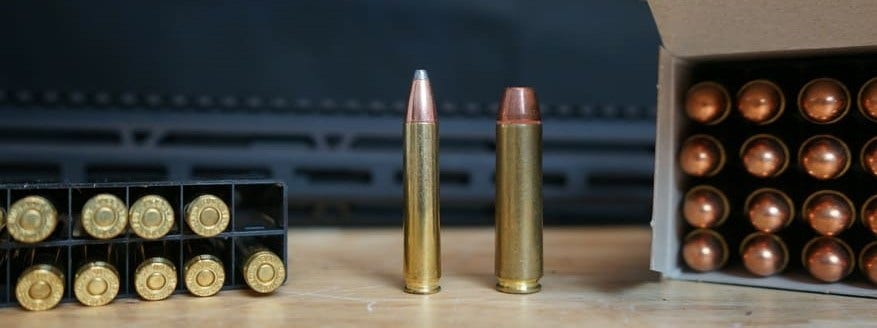In a world of sleek, cutting-edge cartridges seeking to push the boundaries of the AR-15’s effective range and mechanical accuracy, .450 Bushmaster may look like the odd man out – after all, it’s a big, relatively slow-moving, straight-walled cartridge that excels within 200 yards. But those same attributes make it a perfect choice for hunters in the Midwestern United States who can’t legally hunt with bottlenecked cartridges, as well as hunters who are looking for a drop-in upper that will let them bag wild boar, elk, moose, and even bears without having to break the bank.
Origins of the Cartridge
Any discussion of the 450 Bushmaster cartridge’s history has to start with its parent case, the little-known .284 Winchester. While .284 was originally designed in order to get the same performance as .270 Winchester or .280 Remington out of a short-action rifle instead, Winchester specifically sought to use the new round in tandem with their recently produced Winchester Model 100 autoloader and Model 88 lever-action rifles.
Unfortunately, both of those rifles proved to be relatively unpopular – most of the shooters that Winchester marketed them to were looking for bigger bores, and in the case of the Model 100, a tendency for the firing pin to snap and become lodged in the breech bolt face led to a mass recall that seriously damaged the rifle’s reputation.
As a result, the .284 Winchester cartridge fell into relative obscurity – that is, until Tim LeGendre of LeMAG Firearms saw its potential as the basis for a new, hard-hitting, compact round capable of bagging any big game that North America had to offer.
LeGendre took inspiration from Jeff Cooper’s concept of the “thumper” – a large-bore cartridge for semi-automatic rifles that was capable of one-shot kills on big game inside of 250 yards (this same concept is what drove development of other big bore AR-15 and AR-10 calibers such as .458 SOCOM and .50 Beowulf).
LeGendre’s original design was designated the .45 Professional, and LeGendre even personally personally built and delivered an AR-15 chambered in this cartridge to Cooper himself. Afterward, the cartridge was licensed to Bushmaster International, who requested Hornady to produce and load the ammunition.
But when Hornady developed their new polymer-tipped Flex-Tip bullets for use in lever-action rifles, they needed to slightly adjust the .45 Professional’s case length and overall length to accommodate it, which also allowed the round to be operated through the AR-15 platform- and thus the .450 Bushmaster cartridge was officially born.

Unique Characteristics
Straight Walled Cartridge
One of the first things you’ll notice when you look at the .450 Bushmaster cartridge, aside from the impressive size, is the straight-walled case design, which exempts it from the overly complicated and illogical rifle hunting regulations put in place by the Department of Natural Resources in an increasing number of states (but more on that in a moment). In actuality, the case is nottechnicallystraight-walled – there is a very slight taper from base to mouth to make feeding smoother – but it’s close enough to legally slip past DNR case size regulations.
Bullet Weight
The other obvious element that sets .450 Bushmaster apart from much of the competition is the sheer grain weight of the bullet: commonly available in either 250-grain SST or 260-grain AccuTip, and capable of handling bullets pushing 350 grains, to say this cartridge packs a massive punch is an understatement.
In fact, when you look at the ballistic profile of a 250-grain, .452-inch bullet traveling at just over 2,200 feet per second with a muzzle energy of 2,600 foot-pounds, some of the closest points of comparison are the bolt-action and double rifles that were used throughout the 19thand 20thcentury to harvest all manner of big game across the African continent. It’s also a close cousin of the venerable .45-70 Government, which has been a mainstay of Alaskan wilderness guides since the late 1800s, for good reason.

Hunting with .450 Bushmaster
Straight Walled Legality
While it wasn’t the driving force behind the development of the cartridge, there’s no denying that much of .450 Bushmaster’s current popularity comes from the fact that it is legal to hunt with in the Midwestern states that have banned the use of bottlenecked cartridges such as .223 and 5.56 for hunting.
The stated rationale behind these laws is that bottlenecked rounds have substantially higher velocities thanks to using more propellant, which in turn translates into greater effective distances, making them more dangerous in the event that the hunter misses their mark. By comparison, straight-walled cartridges like .450 Bushmaster use less propellant, travel at lower speeds, and rapidly shed velocity past the 200-250 yard mark, meaning a missed shot is much less likely to continue on and strike a building, livestock, or person.
While that makes .450 Bushmaster a great choice for bagging whitetail in the Midwest, where you can find some of the best deer hunting in the country, it would be doing the cartridge a disservice by simply treating it like a legal work-around.
Big Game Hunting
The round was originally developed for big game hunting, and that is certainly an area where it excels. 450 Bushmaster is more than capable of ethically harvesting any and all game you might come a cross in North America, including grizzlies and bull moose. It’s also an excellent choice for hunting hogs in dense brush – even the truly monstrous specimens that grace the covers of hunting magazines are no match for a single well-placed .450 Bushmaster round.
Accuracy
Another great benefit of .450 Bushmaster is its very flat trajectory and high accuracy inside of its effective range – zeroing your rifle in at 200 yards will let you quickly and easily drop deer-sized game out to that distance without having to adjust your hold, and most factory loads will perform within MOA at those distances.

16″ 450 Bushmaster AR-15 Upper with Standard Carbine (3 oz) buffer
A Word on Recoil
The elephant in the room when discussing any big bore AR round is felt recoil, and yes, a 450 Bushmaster upper packs a wallop. The power factor of .450 is not far off from 12-gauge slugs, and you’ll definitely feel that when shooting through a lightweight rifle like the AR-15.
Thankfully, there are a few simple ways to mitigate the issue. First and foremost, a muzzle break will significantly dampen the felt recoil (though you’ll definitely want a good pair of muffs), and a non-slip buttstock with a bit of rubber will make a huge difference compared to the solid plastic or metal of your average mil-spec stock. A heavier buffer like an H2 or H3 is a great way to mitigate recoil as well)

450 Bushmaster vs. 350 Legend
When it comes to straight-walled hunting cartridges for the AR-15, .350 Legend is a new kid on the block, but one that has quickly proven in its worth and carved out a niche for itself. So how does it stack up against .450 Bushmaster?
Stopping Power
When it comes to sheer power, .450 Bushmaster is the clear winner, pushing a 250-grain bullet at a muzzle velocity of 2,200 fps and 2,448 foot-pounds of energy. In comparison, .350 Legend’s typical 180-grain bullet clocks in at at a muzzle velocity of 2,000 fps and a muzzle energy of 1,559 foot pounds. Simply put, .450 Bushmaster throws a bigger bullet at a faster speed, and hits much harder when it connects.
Trajectory
Interestingly, when it comes to trajectory and overall ballistic performance, both rounds perform very similarly. When comparing two rifles with a scope mounted 1.5 inches over the bore, .450 Bushmaster has a trajectory of +3.0” at 100 yards and -13.7” at 250 yards, while .350 Legend checks in at +2.9” and -15.7”, respectively. In other words, they are both very flat shooters inside of 200 yards, with a sweet spot right around the 165-yard mark, and both rapidly start to fall off after 200 yards. Inside of their effective ranges, .350 Legend has a very slight edge, though it’s never going to be the difference between a miss and a clean hit, and past 200 yards .450 Bushmaster takes the lead.
Recoil
No surprise here, 350 Legend is a softer-shooting round with substantially less felt recoil. For younger shooters or shooters with smaller frames, .350 easily comes out on top, and you’ll certainly feel it less after a day at the range. While .450 Bushmaster’s recoil can be tamed quite effectively with a brake, heavier buffer, and good stock, a 350 Legend upper is quite pleasant right out of the box.
Cost
While it’s a bit more affordable than some of the other big bore AR cartridges like .458 SOCOM or .50 Beowulf, .450 Bushmaster is still pricier to shoot than .350 Legend by roughly 50 cents a round on average. It is worth mentioning though that .450 Bushmaster is a great round for reloading purposes, which can certainly make shooting it a slightly more economical prospect. [See our ammo price chart comparing 2021 ammo prices to normal levels.]
Converting your AR-15 to either cartridge is as simple as an upper swap, so in that regard the cost difference is negligible. .450 Bushmaster does have the advantage of feeding in single-stack configuration from a standard 5.56 magazine (though you might want to add a single-shot follower for some extra peace of mind), while .350 Legend requires proprietary magazines but do not require the magazine well to be modified.
Hunting Applications
Both .450 Bushmaster and .350 Legend are great, versatile hunting rounds and popular choices for deer hunters in the Midwest. The question comes down to what type of game you want to hunt – while .350 Legend is more than capable of bagging deer, mountain lions, and pigs, it simply doesn’t have the stopping power to tackle large game like a 450 Bushmaster AR-15. If you’re looking for a versatile cartridge that can drop a whitetail or a moose with equal ease, .450 is the clear choice.
Converting to .450 Bushmaster
Converting an AR-15 to .450 Bushmaster is relatively straightforward – it only requires a new barrel, bolt, and, unless you want to deal with some serious recoil, a muzzle brake, and you will likely need to open up the ejection port a bit in order to clear the larger cases. But unless you’re on a shoestring budget, the simplest option is to swap in a dedicated .450 upper, which provides the added benefit of functionally having two rifles that you can switch between with ease.
As mentioned earlier, .450 Bushmaster can be loaded single-stacked into a standard 5.56 magazine, though obviously at the cost of greatly diminished capacity – a 10-round magazine will hold 4 rounds of .450, a 20-round magazine will hold 9, and a 30-round magazine will hold 12 or 13, depending on the manufacturer. For hunting purposes, a 10-round 5.56 magazine is perfect, since you don’t risk running afoul of any current DNR restrictions. [For maximum reliability, however, Bear Creek Arsenal recommends specific 450 Bushmaster magazines.]


The Bottom Line
If you’re looking for a versatile cartridge that is legal for deer hunting in restricted firearm states while still providing enough devastating power to harvest any and all North American big game, .450 Bushmaster is hard to beat. It’s a classic thumper of a round that shoots flat and punches through thick brush with ease, and inside of 200 yards you can be sure that you will put down anything you hit. While it may not be for everyone, converting an AR-15 to fire .450 Bushmaster is a simple, affordable, and convenient way to provide yourself with options for virtually any hunting scenario.
[Comment your best hunting story below and check out our other helpful blog posts such as our Guide to 50 Beowulf Ballistics and AR10 vs AR15! Shop everything 450 Bushmaster here!]















































